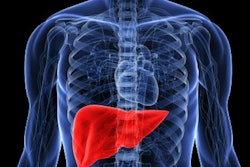Ultrasound elastography can reliably distinguish between patients who have no or minimal fibrosis and those with severe fibrosis or cirrhosis, obviating liver biopsy in most of these cases, according to a multispecialty panel convened by the Society of Radiologists in Ultrasound (SRU).
In an article published online in Radiology, the panel shared the conclusion that shear-wave elastography can distinguish between patients with minimum liver stiffness who probably don't need follow-up, those with severe fibrosis or cirrhosis who need close follow-up, and a group in the middle with mild or moderate fibrosis, lead author Dr. Richard Barr, PhD, of Northeastern Ohio Medical University, told AuntMinnie.com.
 Dr. Richard Barr, PhD, from Northeastern Ohio Medical University.
Dr. Richard Barr, PhD, from Northeastern Ohio Medical University.The panel also determined "that there is some variability between measurements with different equipment, and the appropriate cutoff should be used for each [piece of] equipment," Barr said. In addition, "adherence to a strict protocol is required to obtain accurate measurements."
Delineating elastography's role
Liver biopsy is the reference standard for assessing fibrosis and classifying its stage, but it's invasive and subject to sampling error and interobserver variability in microscopic evaluation, according to the authors. As a result, researchers have been actively evaluating the utility of noninvasive methods such as ultrasound and MR elastography.
With the goal of achieving a consensus on the use of elastography for assessing liver fibrosis in chronic liver disease, SRU organized a panel of specialists from radiology, hepatology, pathology, and basic science and physics. The participants in the panel, which met in October in Denver, analyzed current literature and common practice strategies to come up with their recommendations (Radiology, June 16, 2015).
Remarkably, there was agreement between all parties at the conference, according to Barr.
The panel agreed that a stepwise approach to diagnosing liver fibrosis would be helpful. While patients with decompensated cirrhosis can receive diagnoses clinically, those without overt decompensated cirrhosis can benefit from assessment with ultrasound elastography or MR elastography, according to the panel.
Based on ultrasound elastography measurements, patients can be classified under the Metavir system for quantifying the degree of inflammation and fibrosis of a liver biopsy. Metavir scores are F0 (no fibrosis), F1 (portal fibrosis without septa), F2 (portal fibrosis with few septa), F3 (numerous septa without cirrhosis), and F4 (cirrhosis), with patients categorized into one of three groups based on the scores:
- Normal elastography values: These patients have a low likelihood of cirrhosis (classified as either Metavir stage F0 or F1) and are unlikely to need follow-up.
- High elastography values: These patients have a high risk of advanced fibrosis and/or cirrhosis (includes some cases classified as Metavir stage F3 and all stage F4 cases).
- Elastography values that are neither normal nor high: This group includes those who have moderate to severe fibrosis (categorized as Metavir stage F2 and some F3 cases) and are at risk for progression of the fibrosis, depending on its origin.
Accordingly, the consensus panel recommended that ultrasound elastography results be interpreted using two cutoff values, which differ by equipment manufacturer. One of the cutoff values would be used to select patients at low risk of clinically significant fibrosis, while the other would be used to identify those at high risk for advanced fibrosis or cirrhosis who require different management and prioritization for therapy, according to the panel.
"Between these two cutoff values, there is substantial overlap of fibrosis stages, and it may be that likelihood ratios will be a better tool for documenting risk," the authors wrote. "Additional tests (blood tests, liver biopsy, or MR elastography) and clinical evaluation will be needed to determine appropriate follow-up when values are in the indeterminate range."
As for reporting, ultrasound elastography exam reports should include the median value and the interquartile ratio (IQR)/median value as a measure of quality, according to the authors.
"The report should indicate whether these patients are at minimal risk of having clinically significant fibrosis," the authors wrote. "To allow for improved reproducibility of serial measurements, the patient position and equipment used (both machine manufacturer and transducer frequency) should be reported, so that similar equipment and technique are used in subsequent studies."
The panel also shared recommendations on the technical aspects of performing elastography and reviewed the accuracy of the various forms of the technique.
Future research areas
The consensus panel identified a number of research questions to address, including population and disease differences, spleen measurement, steatosis, and the incidence of hepatocellular carcinoma related to the grade of liver fibrosis.
Barr noted that work is currently ongoing in several crucial areas, such as the effort to standardize equipment measurements by the Quantitative Imaging Biomarkers Alliance (QIBA) Ultrasound Shear Wave Speed Technical Committee. In addition, other projects are seeking to determine if fewer than 10 elastography measurements can be used for an accurate measurement, as well as to clarify factors that influence elastography measurements, such as liver inflammation assessed by abnormal liver enzymes, he said.
Furthermore, researchers are investigating if there's any difference in elastography measurements between pathologies such as hepatitis B versus hepatitis C versus nonalcoholic steatohepatitis (NASH), and if there are any variations between different populations such as Asians and Europeans, Barr said.
"Research is being performed by multiple labs throughout the world," he said. "We hope this consensus document helps to focus that research in areas of most clinical concern."




















